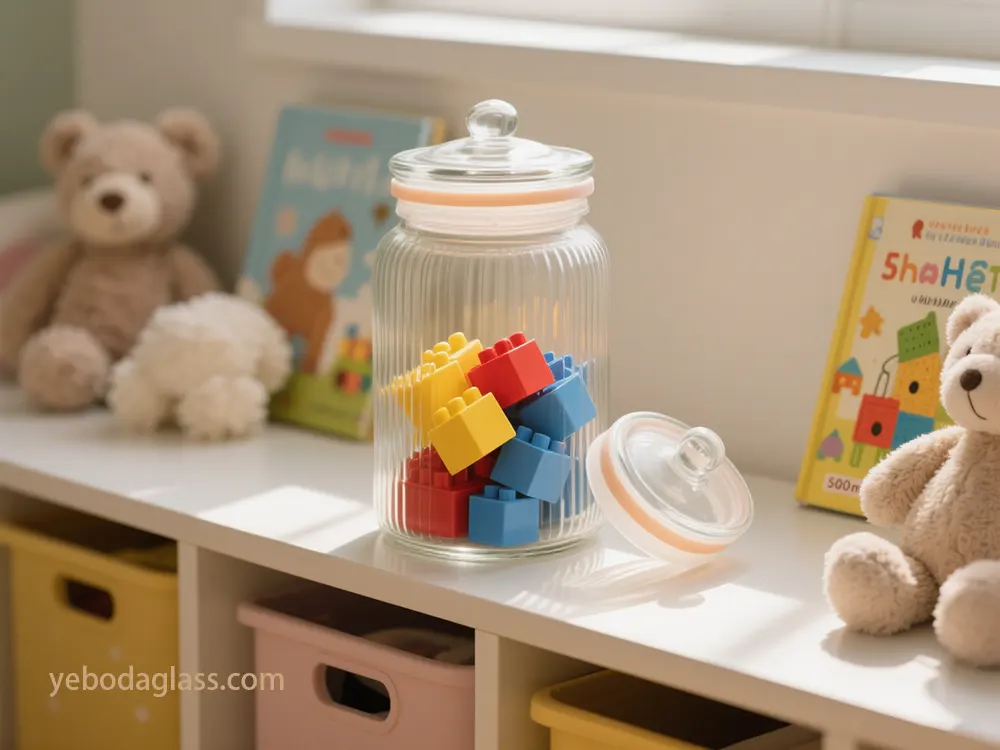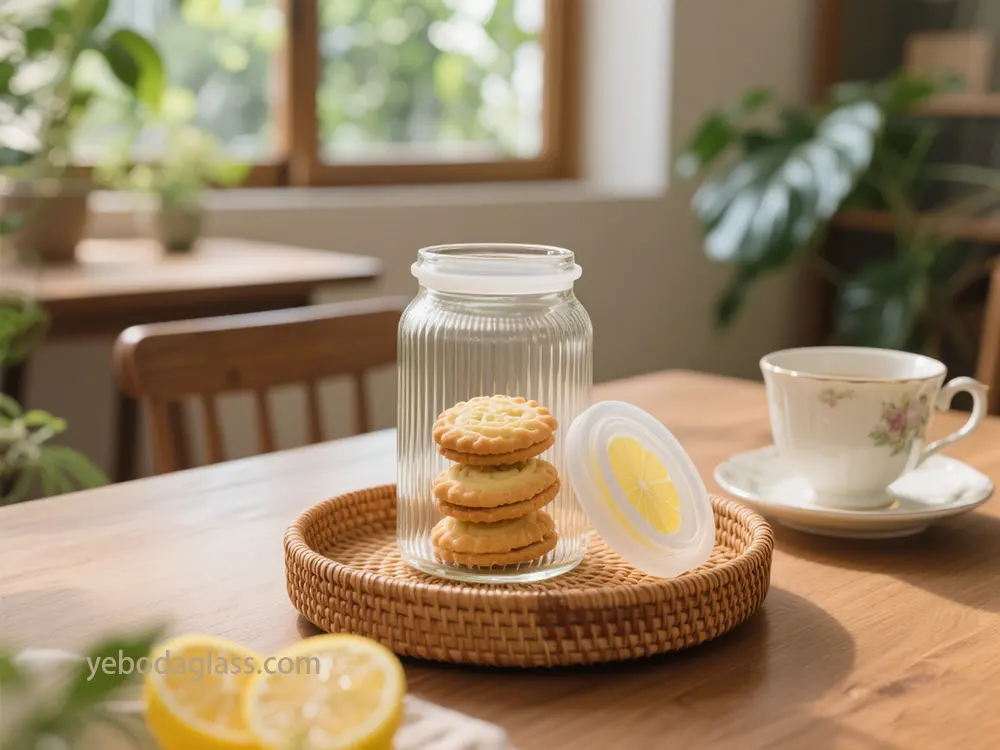Glass boxes are manufactured through blowing, drawing, urgent, and casting.Precision in those methods ensures the faultless finish and constant quality required for premium packaging.
Closed-circuit delivery and interlocked silo filling prevent contamination and incorrect loading.Good mixing and transport systems prevent segregation.
ความสามารถในการติดตาม:
การติดตามอัตโนมัติรักษาอัตราส่วนของวัสดุและอนุญาตให้การปรับเปลี่ยนรุ่นทันทีเพื่อหลีกเลี่ยงความขัดข้อง
การฝึกอบรม:
พนักงานได้รับการฝึกอบรมอย่างเป็นระบบเพื่อเพิ่มทักษะและความตระหนักถึงคุณภาพ ครอบคลุมการเลือกวัสดุแรกเนื่อง การจัดระเบียบรุ่น และผลกระทบต่อการประมวลผล พลังงาน และคุณภาพของแก้ว
4. การควบคุมกระบวนการผลิตสำหรับความสมบูรณ์ของภายนอก
การรักษาความสมบูรณ์ของภายนอกของถุงซีลิกอยู่เป็นสิ่งสำคัญในระหว่างการผลิต YEBODAใช้การควบคุมระหว่างกระบวนการ การตรวจสอบ และการตรวจสอบคุณภาพในระหว่างการประมวลผล การกลม การอบและการติดตัวเพื่อให้แน่ใจความทนทาน ความเท่าเทียมในขนาด และผลิตภัณฑ์ที่ไม่มีความขัดข้อง

4.1. การประมวลผลและการปรับปรุงควบคุม
การประมวลผลแปลงวัสดุแรกเนื่องเป็นแก้วที่ร้อนและหนาแน่นที่ ~1,500°C การตรวจสอบและควบคุมอุณหภูมิเป็นสิ่งสำคัญสำหรับการประมวลผลที่มีประสิทธิภาพ ความเข้มข้นของของเหลว การปรับเปลี่ยนเขตความร้อน และการปรับปรุง Advanced Energy (AE) ให้ระบบเสริมสอบอุณหภูมิและรูมิเทอร์เพื่อการวัดอุณหภูมิที่แน่นอนโดยไม่ต้องสัมผัส Regular การดูแลเตาที่ประมวลผล (การล้าง การตรวจสอบ การปรับแต่ง) เป็นสิ่งสำคัญสำหรับการทำงานที่ดีที่สุดและการหลีกเลี่ยงความขัดข้อง การควบคุมสถานะการแปลงสีของแก้วที่หลอมละลายส่งผลกระทบต่ออัตราการประมวลผลและการปรับปรุง โดยมักจะผ่านการใช้กรดไซลิกและสารลดออกซิเดชัน Cullet ช่วยให้การประมวลผลรุ่นดีขึ้นโดยลบขั้นตอนการระลึกของวัสดุแรกเนื่อง
4.2. การควบคุมกระบวนการกลม
ระหว่างการกลม แก้วที่หลอมละลายถูกทำให้มีรูปร่างเป็นถุง ความล้ำเป็นที่น่าทึ่งของกระบวนการผลิตแก้วแบบลอย ส่งผลกระทบต่อคุณภาพและต้นทุน YEBODAใช้การวัดน้ำหนักของผลผลิตทางด้านบวกอย่างต่อเนื่อง (การควบคุมน้ำหนักรุ่น Plunger Process Control – PPC) เพื่อหลีกเลี่ยงความเปลี่ยนแปลง Infrared cameras ตรวจสอบการกระจายตัวของอุณหภูมิและตรวจจับความขัดข้องทันที
4.3. การอบและการติดตัว
การอบและเย็นช้าให้แก้วเพื่อลดความเครียดภายใน ป้องกันการแตกและฟื้นความเรียบเนียนของโมเลกุลการอบแบบตามความต้องการลดความตึงเครียดทางความร้อนหลังจากการกลมและการอบแล้ว ถุงจะผ่านการติดตัว
4.4. การตรวจสอบโดยไม่ทำลายสำหรับการป้องกันความขัดข้อง
YEBODAรวมการตรวจสอบโดยไม่ทำลายระหว่างกระบวนการสำหรับการตรวจจับความขัดข้องในตอนต้น
การตรวจสอบที่มีคอมพิวเตอร์คือ AI:
ระบบเช่น 3HLE’s RETINA ตรวจสอบที่มีการเรียนรู้ของปัญญาประดิษฐ์ที่ตรวจจับรอยแตกและความไม่ปกติบนถุงแก้วที่สะท้อน/ที่ชัดเจน โดยสามารถแทนที่การตรวจสอบคุณภาพโดยมนุษย์ได้เร็วขึ้นและไม่เหนื่อย ระบบตามกฎทั่วไปมีปัญหากับความสะท้อนของแก้ว ทำให้เกิดการแจ้งผิดบ่อย AI ยังสามารถปรับปรุงพารามิเตอร์การผสมผสาน/การประมวลผลเพื่อเพิ่มความทนทานทางกายภาพและความง่ายในการกลม
การตรวจสอบด้วยปริภาค
การตรวจสอบด้วยปริภาคตรวจจับรูปแบบของความเครียด/การดึงออกในแก้วด้วยแสงที่มีการเปลี่ยนแปลง แสดงความไม่เหมาะสมที่ทำให้คุณภาพแล้วมันระบุถึงการรวมตัว (ช่องว่างของอากาศ/สารแปลกปลอม) ที่เป็นจุดเชื่อมของความเครียด Polariscope ยังหาจุดที่อ่อนแอที่มักจะแตกภายใต้ความเครียด ทำให้ผลิตภัณฑ์ปลอดภัยและการออกแบบดีขึ้น
การตรวจสอบการส่งผ่านความเคลื่อนไหวด้วยเสียง (ART):
ART ตรวจจับรอยแตกที่มีขนาดเล็กในแก้ว โดยเฉพาะสำหรับอุตสาหกรรมยาและการแพทย์ ผสมกับการเรียนรู้ของคอมพิวเตอร์ ART แยกประเภทถุงที่มีความขัดข้องจากถุงที่สมบูรณ์
ระบบการมองเห็นของคอมพิวเตอร์:
ระบบการตรวจสอบแถวต่อไปของ Emhart Glass Vision ที่ด้านเย็นตรวจจับ/ปฏิเสธถุงที่มีความขัดข้องก่อนการจัดเก็บบนแทสเคล ผสมผสานกับเทคโนโลยีทั่วไปและเทคโนโลยี AI การเทคโนโลยีทั่วไปจัดการงานง่ายๆ (ตัวอย่างเช่น การวางเส้นรอบถุง) ขณะที่ AI จัดการงานซับซ้อน (ตัวอย่างเช่น การตรวจจับเส้นที่มีความขัดข้อง การจัดประเภทความขัดข้อง)
รับรู้ผู้ใช้งาน 2D/3D:
- รับรู้ผู้ใช้งานเหล่านี้ใช้การวัดเส้นตัวเลขสำหรับการสร้างภาพ 2D และ 3D จุดกลุ่มสำหรับความเท่าเทียมในขนาด การส่งผ่านความเคลื่อนไหวด้วยเสียงแบบเรียงต่อ:
- วิธีการที่มีการคุณภาพที่ใช้ในการตรวจจับรอยแตกในการผลิตแก้วฉีดยา ระบบการตรวจสอบอัตโนมัติ:
- ระบบเหล่านี้มอบคุณลักษณะการตัดสินใจใหญ่โดยลดความผิดพลาดและเพิ่มผลผลิต Deep learning models (ตัวอย่างเช่น CNNs) ทำงานได้ดีในการตรวจจับความขัดข้องที่เห็นได้เช่นรอยแตกและช่องว่าง Addressing class imbalance (ผลผลิตที่มีความขัดข้องน้อย) ด้วยการเพิ่มข้อมูลช่วยให้การทำงานของโมเดลดีขึ้น 5. ความปลอดภัยทางเคมีและความเหมาะสมสำหรับการสัมผัสของอาหาร
- การให้แน่ใจว่าถุงแก้วเป็นแก้วที่ปลอดภัยทางเคมีและปลอดภัยสำหรับการสัมผัสโดยตรงของอาหาร/ยาเป็นสิ่งสำคัญสำหรับความปลอดภัยของผลิตภัณฑ์ YEBODAปฏิบัติตามการทดสอบที่เข้มงวดเพื่อหลีกเลี่ยงการอุกาหรีย์เคมีและรักษาความสมบูรณ์ของผลิตภัณฑ์ 5.1. Chemical Inertness and Migration Testing
Food-contact glass is chemically inert, stable, and doesn’t release significant elements into food/drink.YEBODA follows specific guidelines for conformity testing of glass FCMs, covering container glass, tableware, and cookware.
Leachable Elements and Heavy Metals:
While generally inert, lead and cadmium release from soda-lime silicate and borosilicate glass can occur due to impurities, though usually below detection limits.Lead and cadmium testing may not be essential for uncolored, undecorated, or unglazed mass-produced glass.YEBODA complies with EU Directive 94/62/EC, limiting heavy metals like lead, mercury, and cadmium.Glass packaging allows higher heavy metal content (up to 200ppm vs. 100ppm for others) due to inherent safety.
Migration Testing Standards:
ISO 6486-1:1999 and ISO 7086-1:2000 outline lead/cadmium release test methods for ceramic/glassware in food contact, using 4% acetic acid at 22°C for 24 hours.The EU’s Overall Migration Limit (OML) applies to total migrating substances, while Specific Migration Limit (SML) applies to individual substances based on toxicological assessment.
FDA Guidelines:
FDA guides FCS migration testing, recommending Appendix II protocols but allowing alternatives.Testing is conducted under the most severe anticipated use conditions (temperature/time).For room-temperature applications, 40°C for 10 days is recommended; for refrigerated/frozen food, 20°C.
Extraction Media:
If drug product vehicle extraction properties differ from water (e.g., pH, excipients), the drug product itself is used as the extracting medium.

QIMA Testing Services:
- YEBODA uses third-party QIMA services for comprehensive lab testing of food packaging/contact items, including visual/dimensional checks, sensory testing, physical hazard assessment, color bleeding, composition, migration tests, and analysis of NIAS, VOCs, heavy metals, residual monomers, and impurities. 5.2. Testing Protocols for Novel Glass Compositions and Surface Treatments
- For novel glass compositions or surface treatments, specific testing verifies chemical inertness and long-term stability. Water Attack Test:
- This test determines alkali resistance of glass containers (especially SO2-treated) by immersing them in water in an autoclave at 121°C for 30 minutes and titrating leached alkali. Solubility Test:
- This test indicates glass hydrolytic resistance and chemical stability under extreme conditions, serving as a QC check. Powdered Glass Test:
- This test estimates alkali leached from powdered glass at elevated temperatures (121°C for 30 minutes). Arsenic Test:
- For aqueous parenteral glass containers, this test involves solution preparation and absorbance determination after reagent addition. Glass Delamination:
- Glass delamination, where particulates form from chemical interaction between drug product and inner glass surface, is a significant concern for pharmaceuticals.This is accelerated by elevated temperatures and formulations with pH > 8.0 (USP 1660).Chemical durability studies monitor this on stability samples in glass containers. Pharmaceutical Glass Types:
YEBODA uses pharmaceutical glass types based on chemical resistance: Type I (borosilicate, high heat/chemical durability), Type II (treated soda-lime, increased chemical resistance), and Type III (regular soda-lime, most common).ISO cartridges for injectables (ISO 13926-1) are commonly Type I Pharma grade borosilicate glass.
6. Post-Production Quality Verification and Packaging
YEBODA’s final production stages involve rigorous post-production quality verification and secure packaging to ensure product integrity and prevent contamination during storage/transport.
6.1. Final Quality Verification
- YEBODA employs a multi-faceted final inspection, combining automated and manual checks. Automated Vision Inspection Systems:
- These systems extensively control packaged item quality, detecting flaws, label defects, code mix-ups, misprinted dates, unaligned labels, batch change errors, wrong labels, surface contamination, and cosmetic defects at high speed.AI automatically checks print and identifies anomalies.Systems from IC Filling Systems and E2M COUTH provide visual inspection for bottles, including linear empty bottle inspection for condition, cleanliness, foreign matter, and liquid residues before filling.High-resolution imaging captures ultra-clear images for detailed 360-degree analysis of structural, surface, and internal bottle flaws. Cap Inspection:
- Cap inspection is crucial for preventing leakage and ensuring product shelf life, verifying complete sealing and defect-free caps. Stress Testing:
- Polariscope inspection examines transparent packaging heat sealing, identifying stressed regions.A continuous color band indicates a good seal; a broken band indicates a fragmented seal.Glass polarimeters use polarized light interference to check internal stress, directly affecting glass strength. On-site Inspection:
- This includes quantity/assortment verification, packaging checks, safety/drop tests, measurements/size checks, labels/markings/logos/barcodes, and aesthetic/visual defect assessment. 6.2. Secure Packaging Methods
Secure packaging keeps product integrity and forestalls infection.
Material Selection for Cushioning:
- Secondary packaging frequently uses cushioning (corrugated cardboard, molded pulp, foam) to soak up transit shocks/vibrations, chosen primarily based on jar fragility, weight, and fee. Barrier Properties:
- Packaging materials provide a barrier against moisture, dust, and contaminants; films, coatings, or laminations beautify these homes. Optimized Packaging Configurations:
- Jar association inside secondary packaging (e.G., cartons) is essential; dividers, walls, or person cells prevent jar-to-jar contact and reduce breakage. Palletization Strategies:
- Proper palletization with interlocking patterns, stretch wrapping, and strapping unitizes masses and forestalls shifting in the course of handling/shipping. Environmental Controls:
- Maintaining solid warehouse temperature/humidity minimizes condensation and label damage, specially for sensitive products. Performance Testing:
- Drop checking out evaluates packaging’s impact protection through losing packaged jars from diverse heights/orientations. Vibration trying out simulates transport vibrations to identify packaging weaknesses, regularly the use of shaker tables. Compression testing assesses packaging’s ability to withstand stacking loads by applying compressive force and measuring deformation. ISTA Standards:
YEBODA adheres to ISTA requirements for packaging overall performance trying out, making sure deliver chain rigor resistance.
Sustainable Packaging Solutions:
Growing fashion in the direction of sustainable packaging: recycled cardboard, biodegradable cushioning, decreased material use.
7.Traceability, Non-Conformance, and Recall Management
- YEBODA implements robust systems for product traceability, non-conformance, and green keep in mind, making sure accountability and fast reaction to protection troubles. 7.1. End-to-End Traceability Systems
- Traceability tracks a product’s journey from raw materials to final destination, providing comprehensive lifecycle understanding.This enhances QC, aids counterfeit prevention, improves efficiency, and supports sustainability. Raw Material Tracking:
- Efficient raw material tracking (silica, limestone, soda ash, cullet) is crucial, supported by robust inventory management systems accurately recording quantities and locations.These systems often integrate with ERP/MRP for data centralization. Batch Record Keeping:
- While “paper-on-glass” systems digitize records, YEBODA moves to fully integrated digital solutions to avoid data silos and ensure real-time validation/audit trails. Unique Identification:
Barcode scanning tracks losses in real-time, assigning unique barcodes to each batch.QR codes on glassware enable easy LIMS registration, documentation, and traceability, preventing mix-ups and controlling allocation.
Electronic Tracking and Reporting:
- Electronic tracking systems allow easy reject reporting, immediately flagging issues and notifying personnel automatically. Vision Inspection Systems:
- High-precision cameras and machine vision systems scrutinize every marked code, ensuring data accuracy and rejecting non-conforming products. Data Management & Software:
- Robust software platforms integrate data from marking, inspection, and other stages, providing real-time insights and comprehensive traceability reports. 7.2. Non-Conformance Management and Quarantine Procedures
- Non-conformance is any deviation from established specifications, quality standards, regulatory requirements, or internal SOPs.YEBODA categorizes non-conformances (product, process, documentation, supplier). Quarantine Procedures:
- Non-conforming products are immediately coded with a quarantine card and moved to designated zones to prevent production use until disposition.Measures include destruction, reprocessing, correction, or further processing without correction.A timeline is linked to each quarantine for resolution, and a detailed form is completed. Deviation Workflow:
- Deviations are planned, approved changes to test methods, lab, or manufacturing procedures. YEBODA’s deviation management system ensures efficient investigation, reporting, and documentation of deviations, including data and classification (critical, major, minor).Process parameter deviations (e.g., time, temperature, pressure) are closely monitored. 7.3. Product Recall Management
- Blockchain technology significantly advances recall management. Blockchain for Enhanced Traceability:
- Blockchain’s decentralized, immutable nature ensures transparency and trust by recording every transaction on a public ledger.Its consensus mechanism validates data, reducing fraud risk.This enables real-time tracking from raw materials to finished products, significantly speeding up recalls and reducing costs. Fraud and Counterfeiting Prevention:
Blockchain’s transparency helps prevent fraud, counterfeiting, and other malpractices.It facilitates rapid supply chain issue identification.
Isolation of Contamination Sources:
Blockchain allows stakeholders to isolate contaminated ingredient sources and trace their supply chain path.
Cost-Effectiveness and Security:
- Blockchain solutions are cost-effective, secure, and provide end-to-end visibility during recalls.Using Polygon EVM can lower gas costs. NIST Project:
- NIST actively demonstrates blockchain’s role in improving manufacturing supply chain traceability and integrity. 7.4. การรวมระบบกับระบบองค์กร
- การรวมระบบ ERP: YEBODA ใช้ระบบ ERP เพื่อปรับปรุงการผลิต คลังสินค้า การขาย และการควบคุมคุณภาพ ระบบ ERP มอบข้อมูลเหตุการณ์ใน thời gianที่จริงและประคบกระบวนการ โมดูลรวมถึงการสั่งซื้อ การขาย คลังสินค้า การผลิต การจัดส่ง และการบัญชี ระบบ ERP รวมกับ MES ผ่าน API เพื่อการดำเนินงานที่สมบูรณ์แบบ
- การรวมระบบ LIMS: LIMS ออกแบบให้เป็นระบบเพื่อประสานงานการทำงานในห้องแล็บ โดยทำให้การติดตามตัวอย่างสะดวก การรายงานที่ประคบ และการเพิ่มผลิตที่มีประสิทธิภาพ LIMS รวมกับ ERP เพื่อการจัดการซ้ากุลเชิงสูง และรวมกับ MES เพื่อเมตริกซ์คุณภาพในระหว่างการดำเนินงาน
- 7.5. การวิเคราะห์เหตุผลหลัก (RCA) และการดำเนินการป้องกันและแก้ไข (CAPAs) RCA:
- RCA เป็นกระบวนการที่มีระบบเพื่อสืบสวนปัญหา ระบุเหตุผลหลายอย่าง ตัดสินใจความสำคัญ และตัดสินใจคำแนะนำ โดยใช้เครื่องมือเช่น ห้าคำถาม แผนภาพ Ishikawa (หางปลา) การวิเคราะห์ Pareto แผนภาพ histogram และต้นไม้ของความผิดพลาด RCA เป็นสำคัญสำหรับการจัดการความไม่ตรงจุดและการป้องกันการเกิดซ้ำ CAPA:
CAPA เป็นเทคนิคการจัดการคุณภาพเพื่อแก้ไขและป้องกันปัญหาที่รู้จัก มันเป็นระบบคุณภาพระดับสูงที่รับรองโดย FDA มุ่งเน้นการปรับปรุงกระบวนการและให้ผลผลิตที่ไม่มีความผิดพลาด การดำเนินการแก้ไขจัดการเหตุผลหลักเพื่อป้องกันการเกิดซ้ำ และการดำเนินการป้องกันเป็นการตรวจสอบและแก้ไขปัญหาที่อาจเกิดขึ้น YEBODA ปฏิบัติและตรวจสอบ CAPA อย่างมีระบบเพื่อลบล้างการเกิดความไม่ตรงจุดซ้ำ และให้ความเชื่อมโยงและการปรับปรุงอย่างต่อเนื่อง
8. การปรับปรุงต่อไปและการจัดการความเสี่ยง
- ความตนเองของ YEBODA ต่อความปลอดภัยของผลิตภัณฑ์และความเชื่อมโยงมั่นคงโดยการปรับปรุงต่อไปอย่างเร็วและการจัดการความเสี่ยงที่มีการดำเนินการเป็นการสร้างความยอดเยี่ยมและความทนทาน 8.1. เทคนิคการปรับปรุงต่อไป
- YEBODA ใช้เทคนิคที่มีอยู่แล้วเพื่อการปรับปรุงอย่างต่อเนื่อง: Lean และ Six Sigma:
เทคนิคนี้ลดอัตราการปฏิเสธ ระยะเวลาการวางแผน และต้นทุนในการผลิตกระดาษหน้าตาม ตัวอย่างเช่น Six Sigma มีผลที่ดีในการสร้างหัวกระดาษหน้าตามและลดกระดาษหน้าตามที่ไม่ตรงจุด Lean manufacturing มุ่งเน้นการลบความผิดพลาด การเปลี่ยนแปลงคุณภาพของผลิตภัณฑ์ และการป้องกันความผิดพลาดที่เกิดซ้ำผ่านการปรับปรุงต่อไป

การควบคุมกระบวนการสถิติ (SPC):
- อุปกรณ์ SPC ช่วยให้ระบุและลดความผิดพลาดโดยการชี้ชัดสถานที่ที่เสียหายผ่านการสังเกตการณ์โดยตรง การตรวจสอบเส้นการผลิต การคิดค้นสิ่งที่ดี แผนภาพ Ishikawa การวิเคราะห์ Pareto และแผนภาพ control charts SPC เน้นการตรวจสอบปัญหาและการป้องกันในตอนแรก โดยเป็นการมีความเป็นผลลัพธ์มากกว่าการตรวจสอบที่สุดๆ ด้วยการแก้ไขปัญหาในระหว่างขั้นตอนการผลิต การจัดการคุณภาพทั้งหมด (TQM) และ 5S:
- TQM และ 5S รวมกันเพื่อเพิ่มคุณภาพโดยลดอัตราการปฏิเสธและระยะเวลาการวางแผน Yokoten:
- Yokoten ส่งเสริมการปรับปรุงต่อไปโดยการส่งเสริมค่าใช้จ่ายลูกค้าและลดการเสียหายขององค์กร 8.2. โครงการการจัดการความเสี่ยงที่มีการดำเนินการ
- แผนการจัดการความเสี่ยงของ YEBODA รวมถึงการประเมิน การวางแผนการลดภาวะ การตรวจสอบ การตรวจสอบ และการอบรม/การทราบความเชื่อมโยงโดยรวม ทางเลือกนี้ลดการหยุดชะงัก ลดต้นทุน และเพิ่มประสิทธิภาพโดยการตรวจสอบและลดความเสี่ยงที่อาจเกิดขึ้น การวิเคราะห์ความเสี่ยงและการดำเนินงาน (HAZOP):
- HAZOP ประเมินความปลอดภัยผ่านการประเมินความเสี่ยงและการวิเคราะห์ความเสี่ยงในพื้นที่การผลิตกระดาษหน้าตามที่สำคัญ HAZOP ช่วยให้ระบุความเสี่ยงที่อาจเกิดขึ้นและปัญหาการดำเนินงานในระบบที่ซับซ้อน การวิเคราะห์ความเสี่ยงของกระบวนการ (PHA):
PHA ช่วยให้ระบุและประเมินความเสี่ยงจากการจัดการสารที่มีความเสี่ยง
- แฮร์ริเคย์ของการควบคุมความเสี่ยง: YEBODA ใช้ตระกูลการควบคุมความเสี่ยง: การลบล้าง การแทนที่/การเปลี่ยนแปลง การป้องกันด้านวิธีการ การควบคุมด้านการบริหาร และ PPE
- Management Review and KPIs: Regular management reviews assess QMS effectiveness. KPIs are crucial for monitoring and improving glass production.Critical KPIs include production yield, defect rate, equipment utilization, order fulfillment, and gross profit margin.Heye International uses KPIs like Pack to Time (PTT) and downtime analysis, monitoring critical defects per million articles.KPI-driven improvements lead to positive ROI.
Audit Findings and CAPAs:
- Audit findings are systematically translated into CAPA investigations, ensuring a healthy QMS.A strong CAPA system supports continuous improvement, maintains certification, and builds customer trust. 8.3. Culture of Continuous Improvement
- YEBODA fosters a continuous improvement culture through management commitment, employee engagement, and aligning strategy with improvement objectives,including: Effective training ensures employees understand and adhere to quality standards/procedures.
Andon Cord System:
The Andon Cord system allows operators to stop the line to address problems, engaging knowledgeable employees to resolve issues.
Digital Transformation:
Moving to a paperless shop floor reduces waste, increases efficiency, ensures data integrity compliance, minimizes human errors, and reduces batch release times.
- 8.4. Future Challenges and Sustainability The glass packaging industry faces evolving safety and sustainability challenges.
- Sustainability as a Driver: Sustainability primarily drives glass packaging demand due to its recyclability and neutral properties.Consumers increasingly prefer glass over single-use containers.
- Lightweighting glass bottles without compromising strength is a key trend to lower material use, transportation costs, and carbon footprint. Recycling Technologies:
- Innovations in sorting/processing recycled glass improve efficiency/cost-effectiveness, encouraging higher recycling rates.Every recycled glass container contributes to making a new one.Challenges include color separation and limited recycling infrastructure in some regionss. Energy Efficiency:
Furnace technology is becoming more energy-efficient to reduce carbon footprint.Projects like ‘Furnace for The Future’ aim to cut CO2 emissions by 60% and achieve carbon-neutral glass production.
Material and Transportation Costs:
- Glass can be heavy, making transport expensive; solutions include local recycling spots. Risk of Breakage:
- Glass is fragile and can break during transport if not properly packaged, leading to product loss and increased costs. Novel Compositions:
- The industry explores novel glass compositions and surface treatments to enhance properties while maintaining safety. YEBODA’s proactive continuous improvement and risk management, coupled with advanced technologies and sustainable practices, positions it as a leader in glass jar product safety and compliance.
- Management Review and KPIs: Regular management reviews assess QMS effectiveness. KPIs are crucial for monitoring and improving glass production.Critical KPIs include production yield, defect rate, equipment utilization, order fulfillment, and gross profit margin.Heye International uses KPIs like Pack to Time (PTT) and downtime analysis, monitoring critical defects per million articles.KPI-driven improvements lead to positive ROI.
- Audit Findings and CAPAs: Audit findings are systematically translated into CAPA investigations, ensuring a healthy QMS.A strong CAPA system supports continuous improvement, maintains certification, and builds customer trust.
8.3. Culture of Continuous Improvement
YEBODA fosters a continuous improvement culture through management commitment, employee engagement, and aligning strategy with improvement objectives,including:
- การให้แน่ใจว่าถุงแก้วเป็นแก้วที่ปลอดภัยทางเคมีและปลอดภัยสำหรับการสัมผัสโดยตรงของอาหาร/ยาเป็นสิ่งสำคัญสำหรับความปลอดภัยของผลิตภัณฑ์ YEBODAปฏิบัติตามการทดสอบที่เข้มงวดเพื่อหลีกเลี่ยงการอุกาหรีย์เคมีและรักษาความสมบูรณ์ของผลิตภัณฑ์ Effective training ensures employees understand and adhere to quality standards/procedures.
- Andon Cord System: The Andon Cord system allows operators to stop the line to address problems, engaging knowledgeable employees to resolve issues.
- Digital Transformation: Moving to a paperless shop floor reduces waste, increases efficiency, ensures data integrity compliance, minimizes human errors, and reduces batch release times.
8.4. Future Challenges and Sustainability
The glass packaging industry faces evolving safety and sustainability challenges.
- Sustainability as a Driver: Sustainability primarily drives glass packaging demand due to its recyclability and neutral properties.Consumers increasingly prefer glass over single-use containers.
- 4.1. Closed-Loop Recycling and Certifications Lightweighting glass bottles without compromising strength is a key trend to lower material use, transportation costs, and carbon footprint.
- Recycling Technologies: Innovations in sorting/processing recycled glass improve efficiency/cost-effectiveness, encouraging higher recycling rates.Every recycled glass container contributes to making a new one.Challenges include color separation and limited recycling infrastructure in some regionss.
- Energy Efficiency: Furnace technology is becoming more energy-efficient to reduce carbon footprint.Projects like ‘Furnace for The Future’ aim to cut CO2 emissions by 60% and achieve carbon-neutral glass production.
- Material and Transportation Costs: Glass can be heavy, making transport expensive; solutions include local recycling spots.
- Risk of Breakage: Glass is fragile and can break during transport if not properly packaged, leading to product loss and increased costs.
- Novel Compositions: The industry explores novel glass compositions and surface treatments to enhance properties while maintaining safety.
YEBODA’s proactive continuous improvement and risk management, coupled with advanced technologies and sustainable practices, positions it as a leader in glass jar product safety and compliance.

